
Original Link: https://www.anandtech.com/show/5866/dell-xps-one-2710-review-the-premium-allinone
Dell XPS One 27 Review: The Premium All-in-One
by Dustin Sklavos on May 29, 2012 9:00 AM EST- Posted in
- Systems
- Dell
- Intel
- XPS
- Ivy Bridge
- Kepler
- all-in-one
- 600M
- NVIDIA
Introducing the Dell XPS One 2710
The last time we reviewed an all-in-one from Dell, our impressions were decidedly less than favorable. Dell delivered a polished software experience, but the Inspiron One 2320 we saw had serious issues virtually across the board in terms of both hardware and configuration. As a family appliance (the market typically targeted by all-in-ones), the Inspiron One 2320 was a bust. Yet with the XPS One 27 (along with the impending Inspiron One 20 and Inspiron One 23) they're looking to reverse their fortunes.
.jpg)
Gone are the poor quality screen, awkward stand, and middling connectivity. In their place we find a PLS screen by Samsung, a more ergonomic stand, and all the modern connectivity you could ask for. Better still, the advent of Ivy Bridge and Kepler promise to shore up many of the hardware weaknesses of the last generation of all-in-ones. So does the new Dell XPS One make the grade? Starting as usual with the hardware specs, here's what we received for review, in bold, with alternate parts listed where applicable (e.g. on the CPU).
| Dell XPS One 2710 Specifications | |
| Processor |
Intel Core i7-3770S (4x3.1GHz, Hyper-Threading, 3.9GHz Turbo, 22nm, 8MB L3, 65W) Intel Core i5-3450S (4x2.8GHz, 3.5GHz Turbo, 22nm, 6MB L3, 65W) |
| Chipset | Intel H77 |
| Memory | 2x4GB Samsung DDR3-1600 SODIMM (Max 2x8GB) |
| Graphics |
Intel HD 4000 (16 EUs, up to 1150MHz) NVIDIA GeForce GT 640M 2GB GDDR5 (384 CUDA cores, 645MHz/4GHz core/memory clocks, 128-bit memory bus) |
| Display |
27" LED Glossy 16:9 2560x1440 Samsung PLS |
| Hard Drive(s) |
Seagate Barracuda 7200.12 2TB 7200-RPM SATA 6Gbps HDD Samsung PM830 32GB mSATA 6Gbps SSD |
| Optical Drive | Blu-ray reader/DVD+/-RW writer (HL-DT-ST CA30N) |
| Networking |
Atheros AR8161 PCIe Gigabit Ethernet Intel Centrino Advanced-N 6235 802.11a/b/g/n Bluetooth 4.0 |
| Audio |
Realtek ALC275 HD Audio Stereo speakers Headphone and mic jacks |
| Front Side |
Webcam Speaker grilles |
| Right Side |
Optical drive Power button |
| Left Side |
Headphone and mic jacks 2x USB 3.0 SD/MMC/XD/MS Pro card reader |
| Back Side |
4x USB 3.0 Ethernet jack Line-out HDMI out HDMI in Optical out CATV in |
| Operating System | Windows 7 Home Premium 64-bit |
| Dimensions |
19.32" x 26.14" x 1.25-2.81" 490.75mm x 664mm, 31.76-71.6mm |
| Weight |
35.16 lbs 15.95 kg |
| Extras |
Webcam Wireless keyboard and mouse Flash reader (MMC, SD/Mini SD, MS/Duo/Pro/Pro Duo) Blu-ray reader TV tuner (Optional) |
| Warranty | 1-year basic support |
| Pricing |
Starting at $1,399 As configured: $1,999 |
Dell wasn't messing around with the new XPS One, and indeed the entire line is the result of their engineers having gone back to the drawing board. Fortunately, as I mentioned before, Dell also benefits from the new technology Ivy Bridge and Kepler bring with them.
The Ivy Bridge-based Intel Core i7-3770S is capable of being almost every bit the performance equal of the i7-3770K, starting from a 3.1GHz nominal clock speed (to maintain the slightly reduced 65W TDP) but able to turbo up to 3.9GHz on a single core, just like the 3770K can. It's only in the in-between turbo modes that the 3770K is able to produce a performance advantage, but the mild reduction in performance coincides with an equally mild reduction in overall power consumption. Honestly I remain a bit skeptical about the need for the S series chips; when Intel's quad-cores had 95W TDPs, a 30W reduction would be a substantial one, but just 12W seems too incremental and you'll see later on that the difference wasn't enough. The i5-3450S is the lower end CPU option for now, which drops the clock speeds and Hyper-Threading, along with a lower price.
What got my attention when I saw the spec sheet for the XPS One was the NVIDIA GeForce GT 640M equipped with GDDR5. Spec wise, the GK107 chip that powers the GT 640M is only slightly weaker than the previous generation's GF116. The GF116 may have been slightly underwhelming compared to AMD's Radeon HD 5770/6770, but it was generally able to get the job done at 1080p. The GK107 loses 8 ROPs and 64 bits off of the memory bus, but has roughly equivalent shader power. 384 CUDA cores clocked at 645MHz aren't bad at all, but when we reviewed the GK107 in the Acer TimelineU I suspected the chip was being memory constrained with just DDR3. Now that we have a system that pairs it with GDDR5, we can see if the increased memory bandwidth will allow the GeForce GT 640M to stretch its legs. Better still, there's the potential here to finally have a reasonably-priced graphics solution that can actually power all-in-ones and justify including discrete graphics hardware.
While the rest of the system's configuration is pretty respectable (with the 32GB SSD configured for Intel's Smart Response Technology), the screen is another big plus. Dell opted to include Samsung's PLS technology display in a 2560x1440 resolution, and it's a thing of beauty. If there's an unusual omission here, it's the lack of touchscreen support on this or even any of the new Dell all-in-ones. While I'm not a fan of large touchscreens, Microsoft has clearly decided to go whole hog on them for Windows 8, and so omitting that feature here seems shortsighted. If you're like some and prefer to stick with the old mouse and keyboard interface, though, you may find more to like here.
The price looks pretty steep at first glance, but you have to consider everything that you're getting. The base model still includes a display that would typically go for around $1000 on its own (Samsung's 27" PLS displays don't come cheap!), so $400 gets you the remaining components for a decent desktop experience. At the high-end, which is what we're reviewing, Dell loads up all the extras: more memory, faster CPU, SSD caching, Blu-ray, etc. There's definitely a case of diminishing returns, but Dell is clearly going after the same market as the high-end Apple iMac. That may not be a great way to go about things, though, since one of Apple's biggest selling points is the uniqueness of their OS X experience. In terms of strict hardware comparisons, however, the XPS One 2710 at $1999 comes out ahead of the current 2012 iMac 27" in quite a few areas. Let's get to the benchmarks now and see just what Dell has to offer.
System Performance
Ivy Bridge is a very strange beast. It's been generally underwhelming for enthusiasts given the middling overclocking headroom stemming from poor thermals, though my experience with it is that you can hit roughly the same overall performance levels as Sandy Bridge at lower clocks and lower power consumption. Where Intel's new chips were born to succeed are laptops and all-in-ones, and I think Dell's XPS One is going to be a solid proof of that.
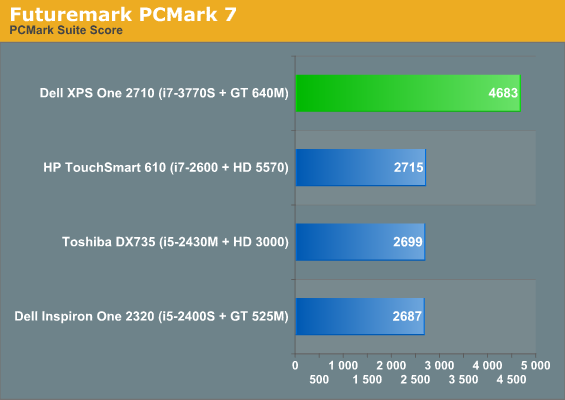
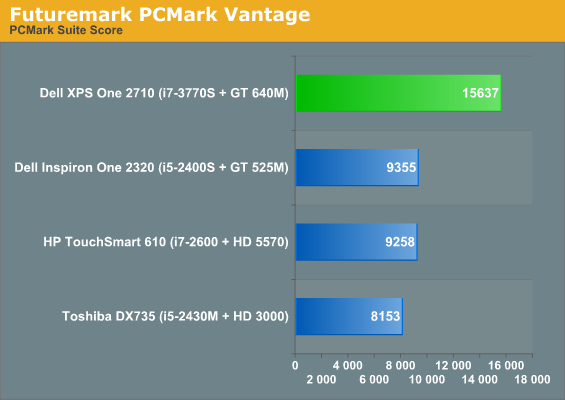
The PCMarks skew heavily towards the SSD caching technology in Dell's XPS One, but the system also features the fastest CPU and fastest graphics of any of the all-in-ones we've tested. Advances in process technology may allow the top end to edge up, but in thermally constrained spaces they can result in big, big performance gains.
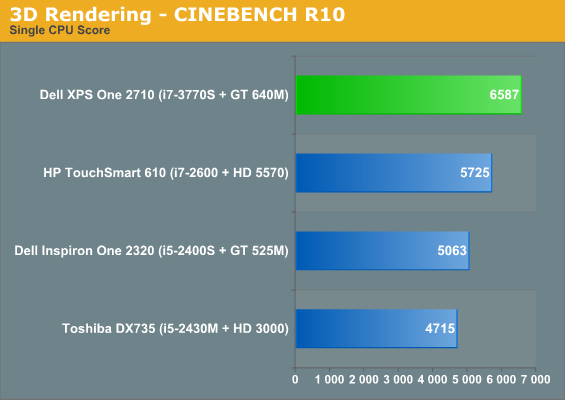
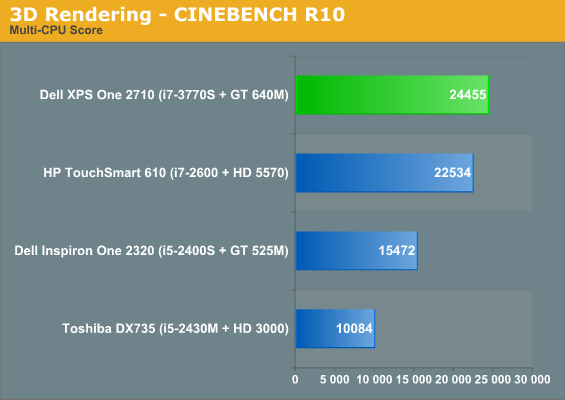
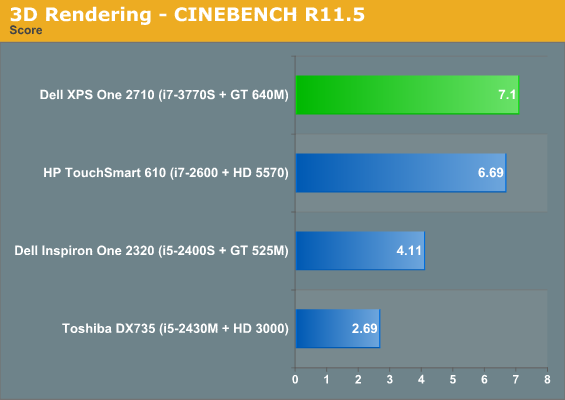
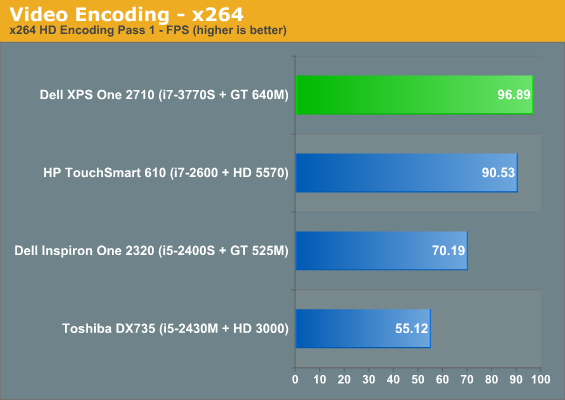
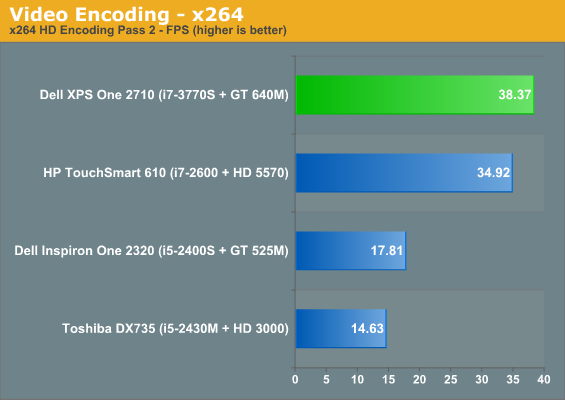
Intel's Core i7-3770S allows Dell's XPS One to soundly beat last generation's top 95W processor (outside of the i7-2700K), but the 3770S chops off a third of the i7-2600's TDP. Performance is up across the board, allowing the XPS One to offer a tremendous amount of power for what's fundamentally a family appliance.
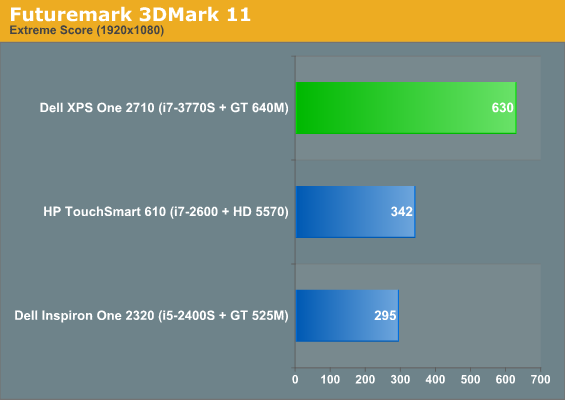
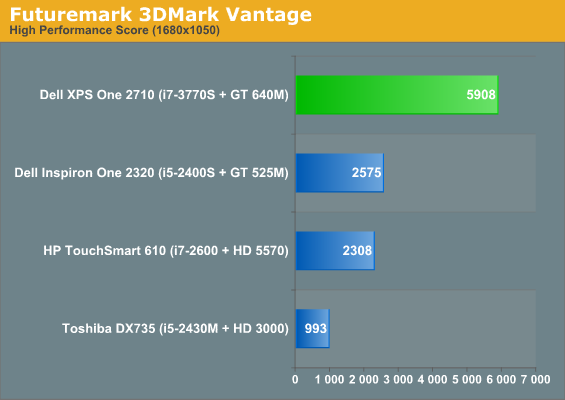
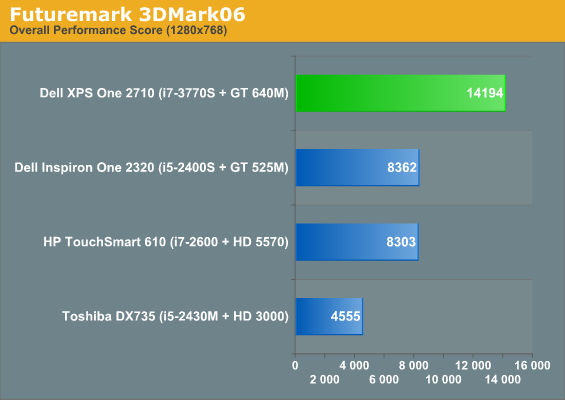
The GDDR5 on the GeForce GT 640M also allows the GPU in the XPS One to stretch its legs, delivering at least twice as much graphics performance as the last generation all-in-one from Dell. At this point I'm convinced going with anything but GDDR5 on all-in-one graphics hardware is unacceptable; either stick with the IGP or go all in. Power consumption isn't as big of an issue with all-in-ones, and the bandwidth afforded by GDDR5 is essential for providing a decent gaming experience at 1080p.
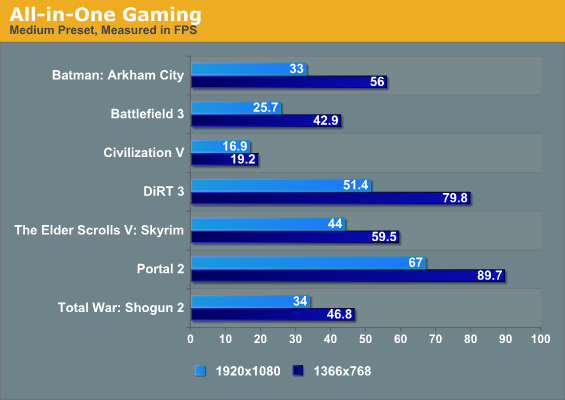
Since the other all-in-ones were benchmarked using our old gaming suite, we only have results for the Dell XPS One 2710. That said, generally speaking it has the chops to game at 1080p. I wouldn't push it to the panel's native resolution of 2560x1440, but you can still have a decent gaming experience on the XPS One. This is a massive improvement over the previous generation. And for those who might otherwise complain about not gaming at native resolution, remember that 2560x1440 on a 27" panel gives a small enough dot pitch that running non-native isn't quite as disctracting as on lesser LCDs.
Screen Quality
When I first powered on the Dell XPS One 2710, I was surprised at just how good the screen looked. I kept trying to do the TN panel test (look at a screen from below and see if it washes out), but it offered stellar viewing angles. What may surprise you is that Dell isn't openly advertising the fact that they're using Samsung's PLS panel in the XPS One instead of a bog standard TN panel; they simply list it as being a 2560x1440 screen and call it a day.
That's really to their detriment, because the XPS One 2710 has one of the best looking panels I've ever seen in an all-in-one, and the increased PPI was enough to make me seriously think about replacing the trio of 24" 1920x1200 panels on my desktop with these higher resolution screens.
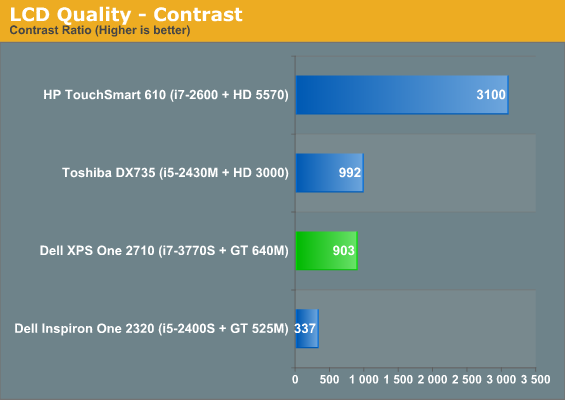
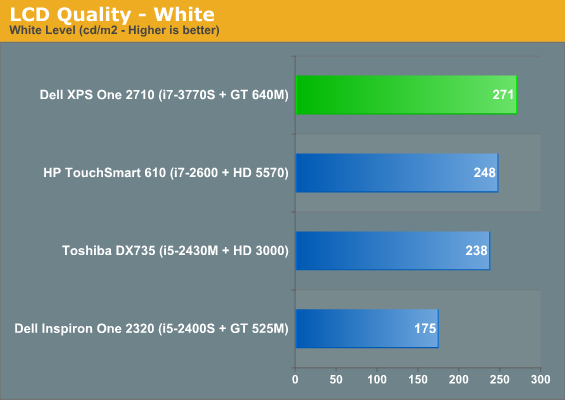
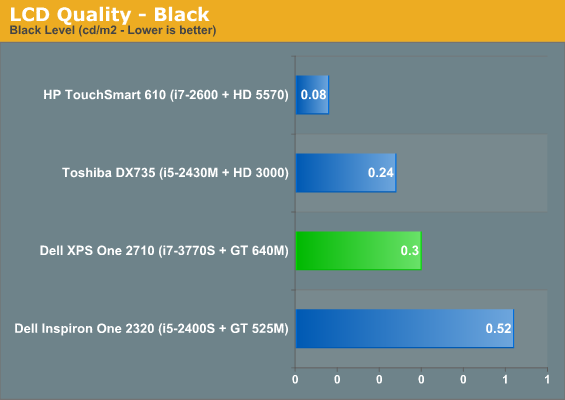
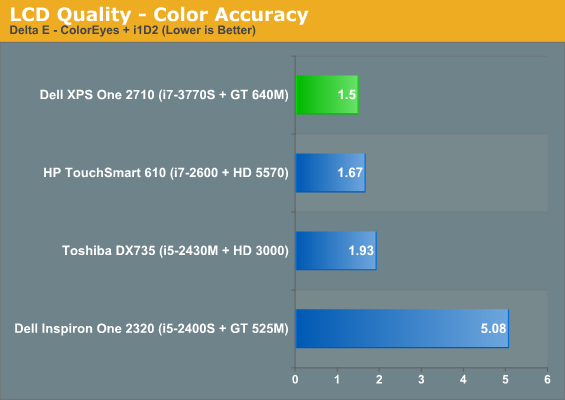
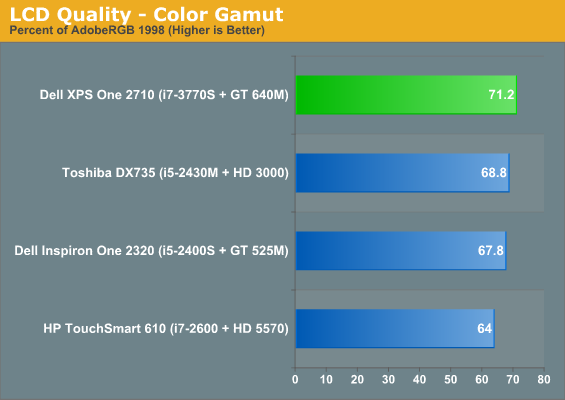
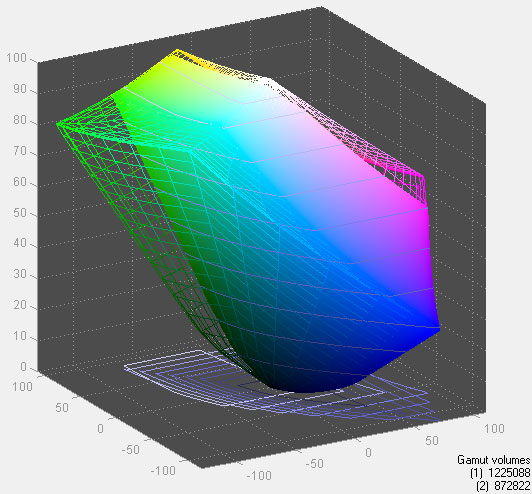
Subjectively it's a terrific looking screen, but the Dell XPS One's panel does seem to have a little bit of trouble with black levels that the IPS in HP's TouchSmart 610 doesn't. I still have a deep abiding preference for *VA panel technology, which produces deep, inky, uniform blacks, but for a media center kind of PC like the XPS One 2710, the PLS panel is probably the best compromise. Motion and responsiveness in games also seemed subjectively solid. As far as other metrics like color accuracy and gamut, the XPS One isn't going to be enough for certain professional users, but that's not really the target market in the first place. For just about everyone else, this is a great LCD.
User Experience, Heat, and Power Consumption
Where I think Dell seems to have missed the boat with the XPS One (and the corresponding new Inspiron One 23 and Inspiron One 20) is in the thermal design. Aesthetically I find these all-in-ones to be very attractive (the Inspiron Ones look almost exactly like the XPS One, just smaller), and once again the minimal software bloat is greatly appreciated.
.jpg)
The problem with the XPS One, and potentially with the other new Inspiron all-in-ones, lies again in the cooling design. If you remember our review of the Inspiron One 2320, we found that while the processor was well cooled, the GPU and hard drive were essentially being toasted inside the chassis. 50C was way too high for a hard drive to be running at, while 90C was pushing the upper boundaries of the GPU's tolerance. That's why it's unfortunate that the XPS One's thermals aren't much better.
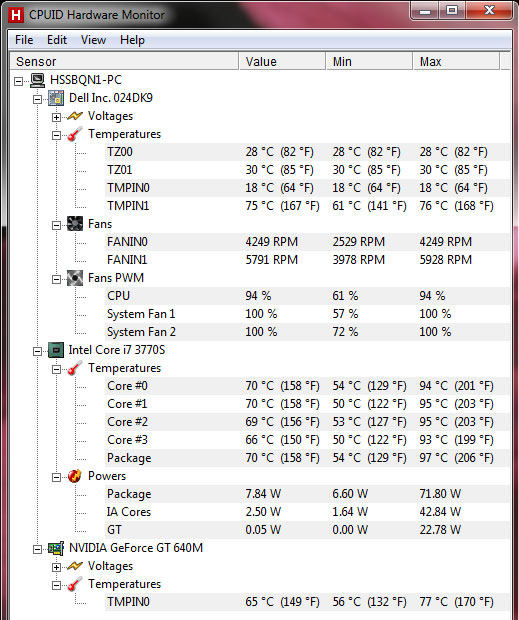
This time the situation is essentially reversed; the i7-3770S is roasting inside the XPS One under high load while the GT 640M is generally more comfortable (77C for any modern GPU really isn't bad at all). Unfortunately, neither HWMonitor nor AIDA64 could give me readings on the storage subsystem so you're really taking it based on faith.
We're really getting to the crux of the problem with all-in-ones, though. Heat management gets a lot more complicated when you're also dealing with the heat that the screen itself is throwing off. Given how much better mobile quad-cores have gotten, I have to wonder if the incremental drop to the i7-3770S was really enough in the XPS One and unfortunately the only other processor choice is the i5-3450S, which is still 65W. Where we need to be are the comparably priced i7-3770T and i5-3450T to take some of the stank off these thermals.
Part of the problem with a system running this hot, is that you'll notice that under sustained stress the system's fans are basically running at full bore, and when that load is removed it takes them a while to spin back down again. Having those fans running that high is brutal; while the system is quiet under idle, sustained load drives fan noise up to a punishing 47.7dB (measured about a foot away). An all-in-one running that loud is unacceptable, full stop.
Dell's thermal solution involves middling ventilation around the perimeter of the body (basically the recessed gap between the screen and the silver backplate), and while I don't envy their engineers the task of having to find a way to cool a beast like this, frankly they just haven't found the answer.
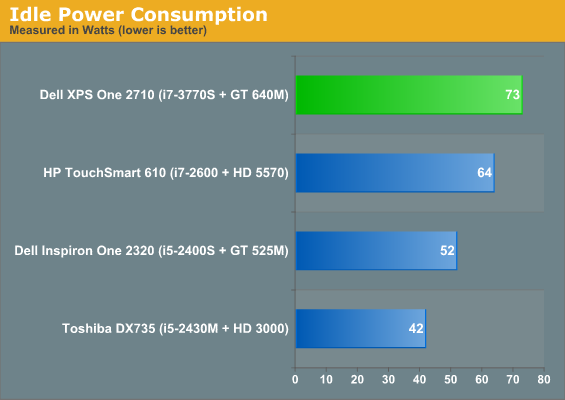
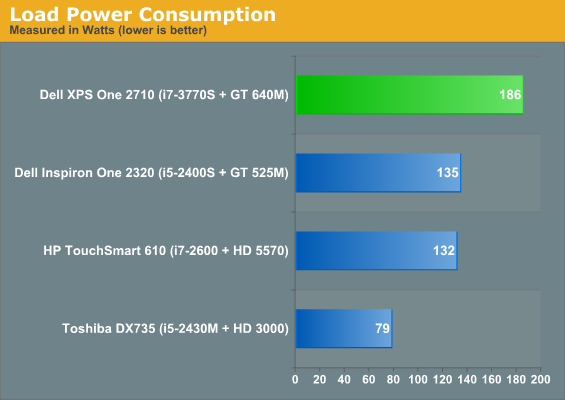
Being the biggest all-in-one we've tested, it should be unsurprising that the Dell XPS One 2710 is also the most power hungry. What's shocking is the difference in load consumption between the XPS One 2710 and TouchSmart 610. If we assume power saving technologies are kicking in (e.g. Optimus for the XPS One 2710), some of the ~10W difference in idle power is due to the larger monitor, but the always-on HD 5570 in the TouchSmart makes that a less than perfect comparison. Regardless, despite having a CPU with a TDP 30W lower than the TouchSmart 610's, the difference in load power consumption sees the XPS One 2710 is pulling fifty watts more than the TouchSmart. The GT 640M simply isn't that big of a power hog, and the difference between the two units should honestly fit in that reduced CPU TDP.
Or if you want a potentially better comparison, look at the Inspiron One, which also uses an NVIDIA GPU with Optimus and a 65W S-series CPU. There the difference at idle is 21W, and once again we're looking at 50W more power draw on the XPS One under load--or 30W more once we remove the extra power used by the 27" LCD.
While load power consumption isn't horrible, it's a lot higher than I expected. Given the cooling issues with the older Inspiron One 2320, it looks like Dell has simply swapped one problem for a different one. We've also seen evidence that Ivy Bridge runs hotter than Sandy Bridge, and that appears to be the case here; more performance in a smaller area often makes that happen. Unfortunately, the noise generated by the XPS One under load makes such high temperatures a real concern.
New Inspirons and the Conclusion
I've mentioned briefly that in addition to the flagship Dell XPS One 27 being launched today, Dell is also launching two smaller Inspiron One systems, the One 23 and the One 20 (take a wild guess what the numbers after the "One" represent). These systems honestly just aren't quite as compelling as the massive 27" XPS One 2710, but they're also more affordable.
The Inspiron One 23 peaks at the same top-end CPU as the XPS One 27, but loses the 27" Quad HD display for a standard 1080p display. You also sacrifice the mSATA SSD, and the GPU takes a major hit, being able to top out at only AMD's Radeon HD 7650A with 1GB of DDR3, rendering it essentially unable to handle gaming at the system's native resolution. For these sacrifices, though, you do go down to a starting price of just $749, making it a more affordable option.
Dell's Inspiron One 20 is their ultra-affordable entry level model. CPUs are still Sandy Bridge generation and top out at the Intel Core i3-2120T, with a TDP of just 35W. No dedicated graphics options are available and worse, the only GPU on hand is Intel's horrendously crippled HD 2000, taking any casual gaming beyond Angry Birds completely out of the equation. The 20" screen is also specced at an anemic 1600x900. On the flipside, the Inspiron One 20 starts at only $529, but it's one of those situations where I'm incredibly disappointed to hear these words from a vendor: "We're committed to Intel." There's no reason to commit to anyone, and an entry level all-in-one like this one is the kind of place where AMD's Trinity would thrive.
So with the broader Dell all-in-one line in perspective, I'm of the unusual opinion that the end user should probably go big or go home. The Inspiron One 23 may offer a compelling enough price-performance ratio, but the One 20 is just too cut down. Meanwhile, the XPS One 27 is essentially the One to go for if you're in the market for a Dell all-in-one. Of course, I wish the situation were so cut and dry.
Big Buddha strike me dead for saying this, but the lack of touchscreen support is, in my opinion, a potentially serious liability. Windows 8 isn't that far away, so to not offer a touchscreen on a premium model like this one is extremely shortsighted in my opinion. I also feel like the 65W processors Dell outfits the XPS One with are just too much for the cooling system. Intel's 45W models may take a bigger hit in performance, but they're better suited to builds like this where thermal headroom is at a premium, and I'm not sure most people using an all-in-one really need much more CPU power than what the T-series offers. Then again, with a 27" display taking up plenty of space, it's difficult to believe there wasn't a better way to keep both CPU and GPU temperatures in check, even under load. Laptops have managed far more with even less space after all.
The good news is that Dell has largely fixed the aesthetic and connectivity from the previous generation, and the screen quality is excellent. If you're not going to push the system too hard the XPS One 27 is probably worth considering. Once again, though, thermals prove to be the Achilles' Heel of an all-in-one, and the lack of foresight demonstrated by the omission of a touchscreen should give you pause. This isn't a bad system, but as always, end users should be cognizant of what they're getting into.

_thumb.jpg)
_thumb.jpg)
_thumb.jpg)
_thumb.jpg)
_thumb.jpg)
_thumb.jpg)






